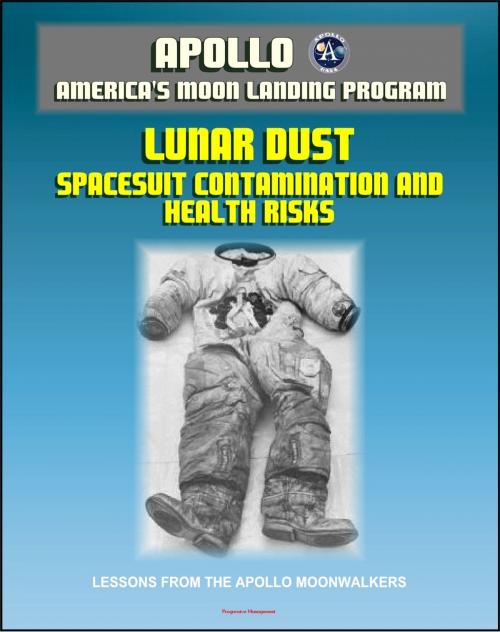Apollo and America's Moon Landing Program: Lunar Dust and Astronaut Spacesuit Contamination, Lessons from the Apollo Moonwalkers, Evaluation of Health Risks to Future Lunar Explorers
Nonfiction, Science & Nature, Science, Physics, Cosmology, Astronomy| Author: | Progressive Management | ISBN: | 9781466131835 |
| Publisher: | Progressive Management | Publication: | December 1, 2011 |
| Imprint: | Smashwords Edition | Language: | English |
| Author: | Progressive Management |
| ISBN: | 9781466131835 |
| Publisher: | Progressive Management |
| Publication: | December 1, 2011 |
| Imprint: | Smashwords Edition |
| Language: | English |
Six official NASA scientific reports are presented in this comprehensive book on the problems and hazards posed by moon dust to lunar explorers, based on the lessons learned by the Apollo astronauts. These documents have been converted for accurate flowing-text e-book format reproduction.
Contents include: The Effects of Lunar Dust on EVA Systems During the Apollo Missions (NASA TM by James Gaier of Glenn Research Center, April 2007); Lunar Dust 101 (NASA presentation by James Gaier; NASA Lunar Dust Filtration and Separations Workshop Report (NASA TM providing the results of a December 2009 workshop); Risk of Adverse Health Effects of Lunar Dust Exposure (statement of health risks as currently evaluated by NASA); The Apollo Experience: Lessons Learned for Constellation Lunar Dust Management (NASA TP from the Johnson Space Center); Lunar Dust Effects on Spacesuit Systems - Insights from the Apollo Spacesuits (April 2009 study of the Apollo spacesuits). Several of these documents provide extensive quotes and commentary from the Apollo astronauts about the moon dust problem.
Excerpts from these reports:
Mission documents from the six Apollo missions that landed on the lunar surface have been studied in order to catalog the effects of lunar dust on Extra-Vehicular Activity (EVA) systems, primarily the Apollo surface space suit. It was found that the effects could be sorted into nine categories: vision obscuration, false instrument readings, dust coating and contamination, loss of traction, clogging of mechanisms, abrasion, thermal control problems, seal failures, and inhalation and irritation. Although simple dust mitigation measures were sufficient to mitigate some of the problems (i.e., loss of traction) it was found that these measures were ineffective to mitigate many of the more serious problems (i.e., clogging, abrasion, diminished heat rejection). The severity of the dust problems were consistently underestimated by ground tests, indicating a need to develop better simulation facilities and procedures.
Largely due to rock and soil samples returned during the Apollo program, much has been learned about the composition and properties of lunar regolith. Although, for the most part, the mineral composition resembles terrestrial minerals, the characteristics of the lunar environment have led to very different weathering processes. These result in substantial differences in the particle shapes, particle size distributions, and surface chemistry. These differences lead to non-intuitive adhesion, abrasion, and possible health properties that will pose challenges to future lunar missions. An overview of lunar dust composition and properties will be given with a particular emphasis on possible health effects.
The presence of lunar regolith dust inside the pressurized volumes was a theme of particular interest. The workshop provided an opportunity for NASA, industry experts, and academia to identify and discuss the capabilities of current and developing air and gas particulate matter filtration and separations technologies as they may apply to NASA's needs. A goal of the workshop was to provide recommendations for strategic research areas in cabin atmospheric particulate matter removal and disposal technologies that will advance and/or supplement the baseline approach for these future lunar surface exploration missions.
Six official NASA scientific reports are presented in this comprehensive book on the problems and hazards posed by moon dust to lunar explorers, based on the lessons learned by the Apollo astronauts. These documents have been converted for accurate flowing-text e-book format reproduction.
Contents include: The Effects of Lunar Dust on EVA Systems During the Apollo Missions (NASA TM by James Gaier of Glenn Research Center, April 2007); Lunar Dust 101 (NASA presentation by James Gaier; NASA Lunar Dust Filtration and Separations Workshop Report (NASA TM providing the results of a December 2009 workshop); Risk of Adverse Health Effects of Lunar Dust Exposure (statement of health risks as currently evaluated by NASA); The Apollo Experience: Lessons Learned for Constellation Lunar Dust Management (NASA TP from the Johnson Space Center); Lunar Dust Effects on Spacesuit Systems - Insights from the Apollo Spacesuits (April 2009 study of the Apollo spacesuits). Several of these documents provide extensive quotes and commentary from the Apollo astronauts about the moon dust problem.
Excerpts from these reports:
Mission documents from the six Apollo missions that landed on the lunar surface have been studied in order to catalog the effects of lunar dust on Extra-Vehicular Activity (EVA) systems, primarily the Apollo surface space suit. It was found that the effects could be sorted into nine categories: vision obscuration, false instrument readings, dust coating and contamination, loss of traction, clogging of mechanisms, abrasion, thermal control problems, seal failures, and inhalation and irritation. Although simple dust mitigation measures were sufficient to mitigate some of the problems (i.e., loss of traction) it was found that these measures were ineffective to mitigate many of the more serious problems (i.e., clogging, abrasion, diminished heat rejection). The severity of the dust problems were consistently underestimated by ground tests, indicating a need to develop better simulation facilities and procedures.
Largely due to rock and soil samples returned during the Apollo program, much has been learned about the composition and properties of lunar regolith. Although, for the most part, the mineral composition resembles terrestrial minerals, the characteristics of the lunar environment have led to very different weathering processes. These result in substantial differences in the particle shapes, particle size distributions, and surface chemistry. These differences lead to non-intuitive adhesion, abrasion, and possible health properties that will pose challenges to future lunar missions. An overview of lunar dust composition and properties will be given with a particular emphasis on possible health effects.
The presence of lunar regolith dust inside the pressurized volumes was a theme of particular interest. The workshop provided an opportunity for NASA, industry experts, and academia to identify and discuss the capabilities of current and developing air and gas particulate matter filtration and separations technologies as they may apply to NASA's needs. A goal of the workshop was to provide recommendations for strategic research areas in cabin atmospheric particulate matter removal and disposal technologies that will advance and/or supplement the baseline approach for these future lunar surface exploration missions.















